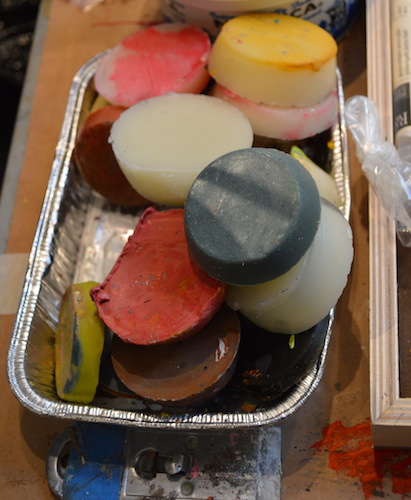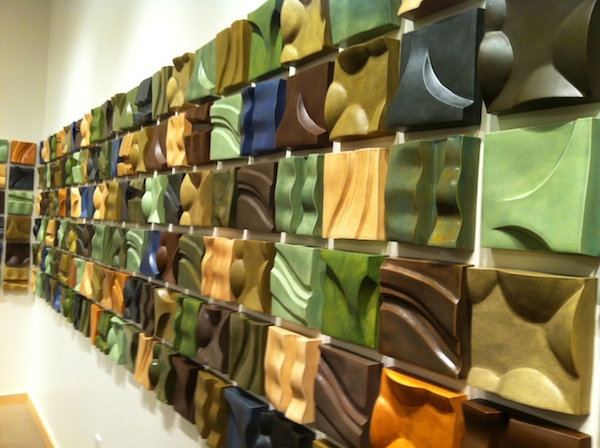The Local newsletter is your free, daily guide to life in Colorado. For locals, by locals. Sign up today!
What goes into preparing for an exhibit of new works? How much time does it take an artist to finish a series? What’s the purpose of a multiple-artist show? These are the questions, among many others, than run through my mind each time I enter a gallery.
In the lead-up to the opening of Urban Abstract–Rural Grid (running through March 8, 2014) at the Museum of Outdoor Arts (MOA) in Englewood, I asked mixed-media artist Patricia Aaron and sculptor Chandler Romeo, those questions. (Full disclosure: I went to university with Aaron’s daughter.) Both Denver artists created new bodies of work for this collaborative exhibition. What follows is a unique insider’s peek at the process behind the show.
That's only $1 per issue!
Click through to see how Urban Abstract–Rural Grid came together.
Patricia Aaron
Though talented in a number of different mediums, Aaron’s current focus is encaustic painting. That type of work is the basis for her MOA pieces, all of which are brand-new. With her two-dozen or so works, Aaron has created a “contemporary montage of culture, graffiti, mark making, and language.” Her micro view on urban scrawl is depicted through square and circular wood pieces as well as 22 metal wall hangings.
Aaron started experimenting with beeswax in her sculptures and paintings during grad school at the University of Denver. Today, she has the process down to a literal science. To create her medium, she melts eight pounds of beeswax slowly in a Crock-Pot. Then, she mixes in demar crystals (sap) until the concoction becomes incredibly thick, like molasses. (The demar makes the beeswax harder and adds shine to the final product.)
She lets that cook for about three hours on low heat before straining it—to remove imperfections—into a large coffee can (can you tell she likes household items?). The mixture is poured into muffin pans (pictured, right) and sets for two hours. After that, she just pops out the wax.
Aaron’s backyard studio—which she calls a “little lab”—is packed with materials. Once her wax is ready, she mixes up her color in tins, places a wax mold in it, and puts the tray on a platform heated to 200 degrees so the wax starts to melt. Aaron chooses not to wash her brushes to keep the colors intact for future projects.
The discs—a novel surface for Aaron—in the early stages of layering.
Regardless of the surface, Aaron employs similar techniques. She paints while the object is flat and then hangs it on the wall to scrape through layers or to cause dripping. A torch helps fuse the layers of wax together. On average, Aaron employs 12 layers of wax and ink to each piece. She’ll dig through layers to find—and create—markings. Aaron was particularly fond of the imperfections found in the circular barn wood she got from Idaho (pictured), from nail and bug holes to divots, and she often worked to bring the cracks to the forefront.
With square panels, Aaron often uses a convertible easel, which allows her to work in any direction. “I confuse it,” she says. Look at the work when it’s right side up, and you can tell how Aaron worked on it. A smooth consistency means she painted while it was horizontal; texture (bumps, roughness) is created when the work is straight up-and-down. It took about seven months to finish all of the square pieces, while the discs required about two-and-a-half weeks each.
Here’s a look at some of the completed works on display at MOA, where the influence of street art is even more apparent. Says Aaron: “I have to live with each one for a while [before I know it’s finished].”
Chandler Romeo
Stop by the MOA exhibit, and you’ll see four of Romeo’s installations: three flat (two of which have been on view, in part, before) and a set of wall sculptures. The consistent theme that runs throughout is taking a macro look at landscapes (albeit, an abstract view) and how human and natural intervention affect those settings. “We defy the natural lands a lot of times,” Romeo says. “We just lay a grid on it.”
The inspiration behind one of the new surface installations pieces should be familiar to Coloradans. Romeo hand built clay mountainlike sculptures. There are a total of 54 peaks represented—equivalent to the number of fourteeners in the Centennial State.
“I was going crazy with all this flat work, so I needed to build up,” Romeo says of this series (pictured in various stages of completion). The “painstaking” process primarily revolved around clay scraps. Romeo would simply grab a piece and start wrapping it around the work, and letting those leftovers determine how large the sculpture would be.
“It was a slow process of joining bits of clay,” she says. “But it was meditative.” She played with the glaze to make the color as close to rock as she could. When laid on too thick, it can take on a greenish hue.
Romeo’s other new work is a wall installation. This kiln did a lot of heavy lifting during the process, heating up to 772-degrees as many times as Romeo needed to create more than 300 ’tiles.’
The step-by-step slip casting method starts with Romeo pouring liquid clay into molds made by a friend. She settled on four shapes (more on that on the next page) and had four molds made of each. After pulling the clay out of the mold, she trimmed the excess, cut holes in the back for hanging, and let the piece dry. Then they were each fired in the kiln. Round one: done.
Each shape (all pictured here) depicts a different intrusion into the natural geography: a roadway or other human cut across the landscape; a road/riverbed/channel; ditches; and an organic, “accidental earthscape” that looks like hills.
The kiln turns the clay white. Romeo adds earth tones by hand-painting the glazes on each piece individually. For this project, she used 12 manufactured glazes (she chooses not to make her own) and 14 different colors. She applies three coats to each—using numbered cards (1, 2, 3) to remind herself where in the process she is—before firing everything again in the kiln. Brushwork determines the final appearance. Some were done with linear (aka regular) back-and-forth painting, while others were more random to create a more natural (literally and figuratively) appearance.
A peek at the final product on display at MOA. Remember: Visit the show before it closes on March 8, 2014.
—
Bonus: Get a behind-the-scenes look at the works of more local artists with our Meet the Artist series.






















